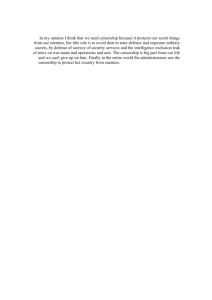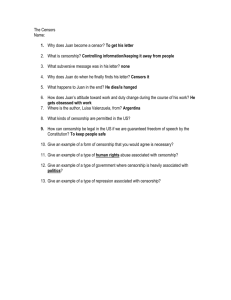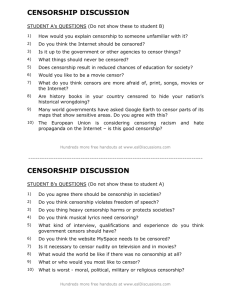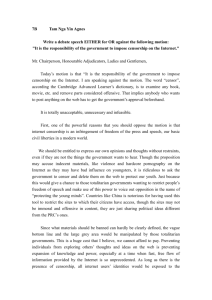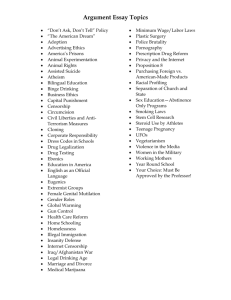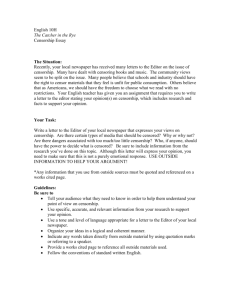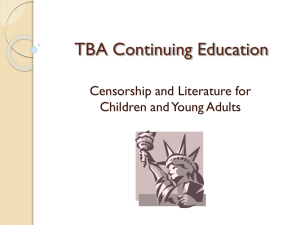censorship handout
advertisement
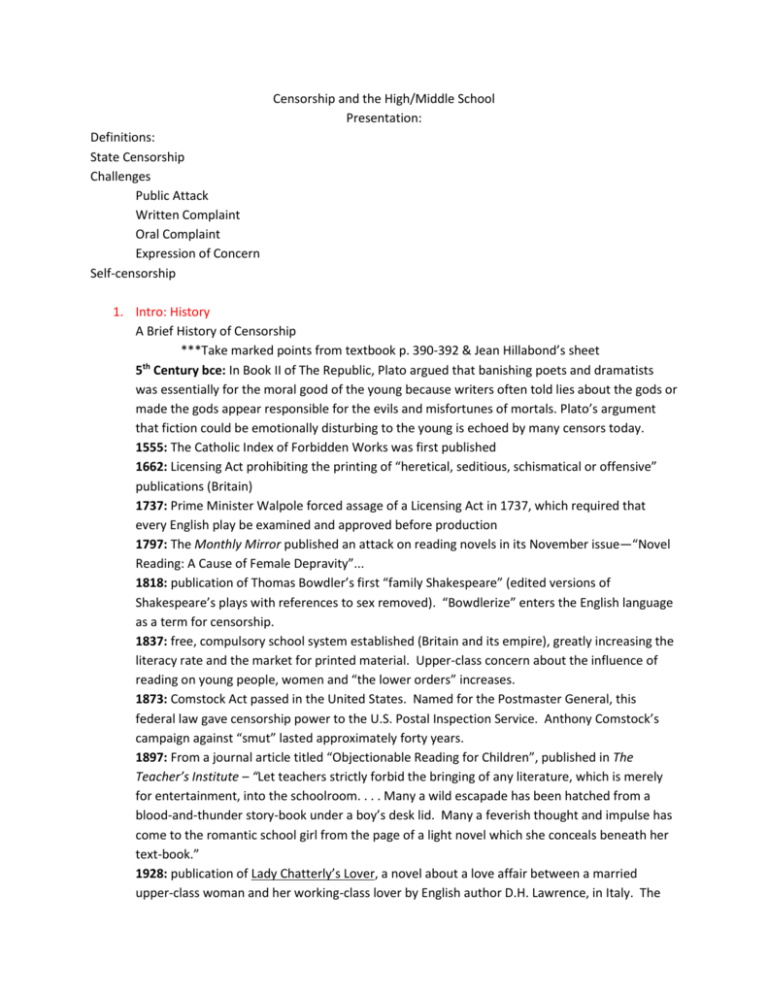
Censorship and the High/Middle School Presentation: Definitions: State Censorship Challenges Public Attack Written Complaint Oral Complaint Expression of Concern Self-censorship 1. Intro: History A Brief History of Censorship ***Take marked points from textbook p. 390-392 & Jean Hillabond’s sheet th 5 Century bce: In Book II of The Republic, Plato argued that banishing poets and dramatists was essentially for the moral good of the young because writers often told lies about the gods or made the gods appear responsible for the evils and misfortunes of mortals. Plato’s argument that fiction could be emotionally disturbing to the young is echoed by many censors today. 1555: The Catholic Index of Forbidden Works was first published 1662: Licensing Act prohibiting the printing of “heretical, seditious, schismatical or offensive” publications (Britain) 1737: Prime Minister Walpole forced assage of a Licensing Act in 1737, which required that every English play be examined and approved before production 1797: The Monthly Mirror published an attack on reading novels in its November issue—“Novel Reading: A Cause of Female Depravity”... 1818: publication of Thomas Bowdler’s first “family Shakespeare” (edited versions of Shakespeare’s plays with references to sex removed). “Bowdlerize” enters the English language as a term for censorship. 1837: free, compulsory school system established (Britain and its empire), greatly increasing the literacy rate and the market for printed material. Upper-class concern about the influence of reading on young people, women and “the lower orders” increases. 1873: Comstock Act passed in the United States. Named for the Postmaster General, this federal law gave censorship power to the U.S. Postal Inspection Service. Anthony Comstock’s campaign against “smut” lasted approximately forty years. 1897: From a journal article titled “Objectionable Reading for Children”, published in The Teacher’s Institute – “Let teachers strictly forbid the bringing of any literature, which is merely for entertainment, into the schoolroom. . . . Many a wild escapade has been hatched from a blood-and-thunder story-book under a boy’s desk lid. Many a feverish thought and impulse has come to the romantic school girl from the page of a light novel which she conceals beneath her text-book.” 1928: publication of Lady Chatterly’s Lover, a novel about a love affair between a married upper-class woman and her working-class lover by English author D.H. Lawrence, in Italy. The British Home Secretary ordered Customs officials to seize and destroy copies imported into Britain. 1985: First seizures by Canada Customs of material odered by Little Sisters Book and Art Emporium in Vancouver from U.S. sources. 1989: Ayatollah Ruhollah Khomeini, Supreme Leader of Iran, issued a fatwa against author Slman Rushdie for writing The Satanic Verses, a novel based partly on the life of Mohammed which had won a literary award in Britain when it was published in 1988. The fatwa encourages all Muslims to kill the author and anyone else associated with the book. Rushdie was placed under police protection in Britain. **This just shows that debates about intellectual freedom and censorship have been a part of society for centuries. 2. Competing Viewpoints -right to access to materials -reasons for wanting materials censored 3. Overview of the issues (categories of censorship) “The answer to the question of what censors censor is easy—almost anything. Books, films, magazines, anything that might be enjoyed by someone is likely to feel some censor’s scorn and moral wrath. . . . Some works, however are more likely to be attacked.” P.399 “The announced objection may not always be the real objection. Censors might attack Huxley’s Brave New World or Orwell’s 1984 for their sexual references when the real objection is to the frightening political attitudes the authors displayed (or were thought to display). It is human nature to fear things we do not understand; hence the discomfort that many parents feel over the recent popularity of scary, supernatural books.” P. 390 There are countless objections that people may have about many pieces of literature, but we’ve narrowed down a few major categories... a. Political Correctness/Stereotyping -sex role stereotypes eg. The Flintstones -ethnic stereotyping eg The Merchant of Venice “Dirty Words”/Profanity -Lord of the Flies – contains racial slurs -“expropriation of voice” – who gets to write the stories? b. Depiction of Race/Racism In Search of April Raintree – “Negative portrayal of a Metis girl, role stereotyping and degradation of women,” explicit sex, violence. To Kill a Mockingbird The Adventures of Huckleberry Finn c. Violence King Lear Slaughterhouse Five Contradiction: Often, objections made are based on religious grounds, and “many of those peole hold up the Bible as the best (or only) example of literature they want children to read, ignoring the fact that the Bible overflows with sex, violence, treachery, betrayal, theft, adultery, incest, bigamy, illegitimacy, and mayhem. People in the Bible, in fac, are killed in as may createive ways as one can find in any of today’s supermarket tabloids: stabbed, slashed, stoned, hanged, burned to death, nailed to crosses, and in one instance a spike is driven through a man’s temple, pinning him to the floor. Isn’t that lovely?” –BOLD BOOKS FOR TEENAGERS d. Sexual Morality -sexuality -explicit content -sex education – AIDS literature, abortion e. Religion i. Witchcraft ii. Secular humanism/creationism f. Inappropriate Adolescent behaviour 4. Some censored/challenged books in schools -object of challenge Of Mice and Men The Golden Compass Nineteen Eighty-Four Bridge to Terabithia Harry Potter To Kill a Mockingbird The Lorax -positive aspects 5. Censorship in the classroom a. How can we deal with potential censors? Communication—It is important to ensure that your students’ parents are aware of what is going on in your classroom. Maintaining an open relationship with them will provide the parents with the tools to understand your approach to material and appreciate what you are doing in your classroom. Written Rationale— an important thing to have on hand should a would-be censor come calling—and probably a useful tool in deciding which texts to use in your classroom anyway. This should outline your purpose in using a text in your classroom and should list any awards, literary reviews, or other accomplishments. Policies and Procedures—if a parent does not want an individual child to read a certain text, individual program changes should be made. If, however the parent wants the book banned from the school entirely, he or she should be made to follow the steps of an official procedure. “Every school should develop a policy and a procedure that helps both educators and objectors when an incident arises. The aim of both policy and procedures should be to ensure that everyone has a fair hearing, not to stall or frustrate anyone.” P. 395 All formal complaints against a text should be done initially in writing. This will allow for documentation of the case and will also hinder inaccuracies and support weak memories. The school or board’s materials’ selection policy should contain specific procedures in the event of a challenge. Ther needs to be a defined course of action for th e teacher, the complainant, the principal, and school board officials. Otherwise there is a danger that the process of considering the book might be hijacked by an administrator who is trying to silence publicity. b. What are some suggestions for personal selection criteria? 6. Closure – reading of marguerite laurence’s letter to the teacher Notes – quote on board Useful/interesting links Forbiddenbooks.com Freedomtoread.ca ***For Tuesday, need to find challenged books and bulk up the outline w/ content. -intellectual freedom manual
